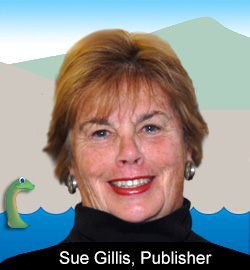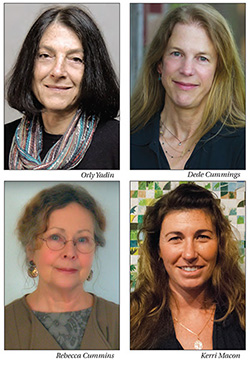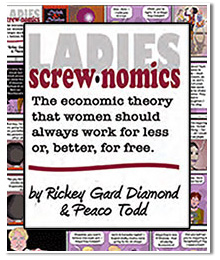Index - June, July, August 2014 |
|
| Embodying the Mystery Called "Champ" |
| by Cindy Ellen Hill |

© Chris Reilly / Jan Doerler
|
Treasured memory. Harbinger of ecological trouble. Lucrative souvenir logo. The product of one too many gin and tonics.
Champ, the denizen of Lake Champlain spotted by thousands of people over hundreds of years, is all of these things.
“It’s part of our folklore,” says Dee Carroll, co-owner with her husband of the Westport Marina and Galley Restaurant in New York, straight west of Button Bay and Basin Harbor. Dee began boating Lake Champlain in 1969, and found Champ a frequent topic of conversation.
“Some people said they saw things on the lake that were Champ, or that they thought were Champ. People were seeing something. It could be real, or it could be an artifact, like a wake from a boat that had passed some time ago.”
Continue Reading...
|
|
| Publisher's Message: Champ! Are you Really Out There? |
| by Suzanne Gillis |
|
Okay. I admit it. I saw Champ. Or did I?
I remember the date exactly. Because when you see Champ, you remember the date. Friday, September 16, 1994 at 6:05 p.m. Where? On my deck, which overlooks the east-facing Inland Sea in the Champlain Islands. I was with a property appraiser, who had just finished his appraisal. I had never met him before.
So here is the scene. The air was clear. Like glass but clearer, no reflection. Not a cloud. No wind. Not a so much as a dimple on the Lake surface. The sun had set. No afterglow. Dusk approached in shades of gray monotones, as the lake, sky and mountains often are.
Continue Reading...
|

Photo: Jan Doerler |
|
| Driving Vermont's Creative Economy |
| by Cynthia Close |

OrlyYadin, Dede Cummings, Rebecca Cummins, and Kerri Macon, each unique in personality and character, are just four examples of exceptional women drivers of Vermont’s creative economy. |
Three years ago, I moved to a new home in Burlington, anticipating retirement, while still commuting to Boston to my job as President of Documentary Educational Resources (DER, a film distribution/production company). The commute showed me a beautiful state and filled me with enticing thoughts of idyllic days ahead. Then a Burlington friend suggested I apply for a newly established full-time position of Vermont’s Director of Creative Economy.
It’s tough to turn down an opportunity. Intrigued by the job title, I applied, and was called in for an interview. I learned a lot. While the position was new, I was surprised to discover that Vermont, along with five other state arts agencies under the auspices of New England Foundation for the Arts (NEFA), have been engaged in research projects over the past 37 years. They sought to demonstrate the economic force of the cultural sector.
Defining what was actually meant by “the creative economy” was challenging. The NEFA released a comprehensive 64-page report that included a national taxonomy that used the North American Industrial Coding System (NAICS) for job classification. Job titles gave some clarity to the economic and business potential, such as NAICS #511130 Book Publishers and #512120 Motion Picture And Video Distribution, and #711510 Independent Artists, Writers And Performers.
Continue Reading...
|
|
Genetics Network Links Vermont Colleges in a “Culture of Research” |
| by Tatiana Schreiber |

(top) Dr. Elizabeth Dolci, chair of the Biology Dept. at Johnson State College, one of seven VGN Partners. (Photo: Don Landwherle) (bottom right) Katheryn Sperry, a psychologist at Castleton State College, recently received a grant from VGN.(bottom left) Vermont Genetics Network Director, Dr. Judy Van Houten.
|
Dr. Judith Van Houten coordinates a statewide network, manages a multi-million-dollar budget, and oversees the development of new facilities across the state that are inspiring a growing list of Vermont researchers. Director Judith Van Houten, the George H. Perkins Professor of Biology at the University of Vermont (UVM), has shepherded the Vermont Genetics Network (VGN) since its inception nearly ten years ago. VGN nurtures and connects what Van Houten calls “a culture of research” at seven partnered colleges. It also funds student researchers at the BA level—where budding women scientists are most often found.
The VGN is part of a National Institutes of Health initiative called IDeA Networks of Biomedical Research Excellence (INBRE). The network’s design,“a pipeline for biomedical researchers,” Van Houten explains, intends “to bring diverse people into the fold, so that Vermont has the workforce it needs in biomedical technologies.”
UVM serves as the lead institution,linking partners at seven Baccalaureate Partner Institutions (or BPIs): Castleton, Johnson and Lyndon State Colleges; Middlebury College; Norwich University; Saint Michael's College and Green Mountain College. From beginning to end, VGN helps faculty and students, as they design research projects, submit proposals, carry out the projects, and present their results.
Continue Reading...
|
|
| The Adoption Option: Another Route to Parenting |
| by Elayne Clift |

Adoptive Families
(top) Stephen, Bonnie & Colton
(bottom)
Brian, Jon & Ian
|
After several miscarriages, multiple diagnostics, an intrauterine insemination, and holistic approaches, Susan Baxter and her husband began a rigorous adoption process in 2011; two years ago, the agency they worked with “cleared them” for adoption. The long waiting is stressful, and she continues to experience “cycles of grief.”
Susan’s biggest worries included the financial risks, the birth mother’s possible substance abuse, and “the potential of not bonding.” She and her husband are now thinking about choosing to be childfree.
Susan says they “have to move on with [their] lives.” They may try fostering children who need homes, or volunteering as hosts through Fresh Air Kids, which brings inner city children to Vermont.
After several miscarriages, Casey Johnson and her husband began researching adoption in 2012. They found an agency they trusted. They talked with many adoptive parents who’d had positive experiences. But as the couple came closer to entering a contractual agreement with the agency, they realized they weren’t emotionally ready.
Continue Reading...
|
|
| Learning Adventures You’ll Love and Remember |
| by Sarah Galbraith |

A new breed of vacationers is looking for more than the typical retreat. Lauren Lavallee and Bradley Auclair wanted to help save Africa’s lions, but meaningful vacations range widely. |
Lauren Lavallee wanted a more meaningful vacation. “I had been to beach resorts and on cruises, but they didn’t feel like what I wanted a vacation to mean.” Lavallee, who is community outreach coordinator with Logic Supply Co. in South Burlington, and Vermont Woman’s Tech-Connect columnist, told us she had decided to look for a volunteer vacation. Something in a different country. And working with animals.
Lavallee searched online for “volunteer Africa,” then “volunteer Africa animals,” and then she had it: two weeks in Zimbabwe working on a lion conservation. Lavallee had found African Impact, a volunteer travel organization with locations around the African continent, including the site she finally chose. Antelope Park is a lion preserve with a breeding program in Zimbabwe.
She and her friend and traveling companion, Bradley Auclair, paid $2,000 each for the opportunity to live and work at the park for two weeks, including food, lodging and activities. It cost another $2,000 each for round-trip plane tickets. Once there, they would care for the lions, take paying customers on walks with the lions, and help with feeding, cleaning, and other chores.
Continue Reading...
|
|
| Screwnomics: The economic theory that women should always work for less or, better, for free. |
| by Rickey Gard Diamond & Peaco Todd |


|
Building on our editor’s National Newspaper Award in 2012 for her economic reporting, An Economy of Our Own series, Vermont Woman now introduces a new economic cartoon, written by Rickey Gard Diamond and illustrated by Peaco Todd.
Congratulations to Rickey for her recent selection for a residency at Hedgebrook, the nation’s only writer’s retreat with a commitment to “visionary women writers.” She’ll be on Whidbey Island off the coast of Washington this coming month, working on a book she’s tentatively calling Making Economics Sexy: What Women Need to Know To Make Change. She says, the book’s definitions of economic terms will include cartoons.
Continue Reading...
|
|







